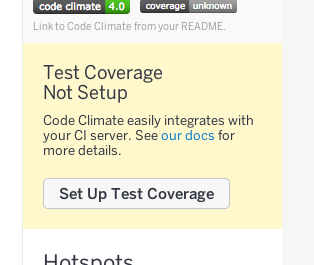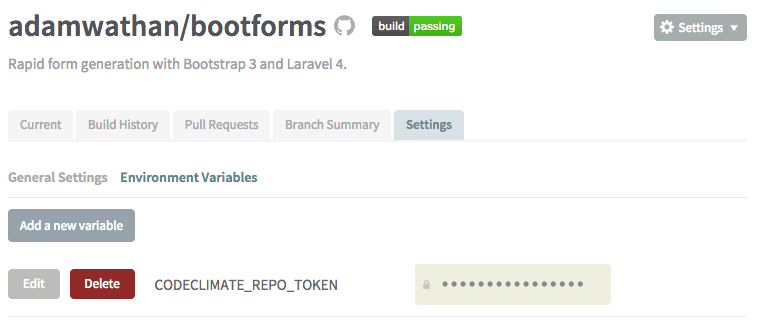This weekend I decided to add test coverage analysis for a few of my projects. I was already using Travis CI for running my tests and Code Climate for code quality analysis, so I thought I would try and set it up with the tools I was already using.
If you're unfamiliar, test coverage analysis just tells you what percentage of your code is actually executed when you run your test suite. It's not necessarily an indicator that your tests are any good, but it can be helpful for tracking down untested code.
Code Climate and Travis CI both have documentation for setting this up, but both of them left out enough important steps, or were just wrong in enough ways that I thought I'd go over what I had to do to actually get it working.
1. Find your Code Climate repository token
This is literally all you need to do with Code Climate.
Open your repository in Code Climate and look for the button in the right hand column that says "Set Up Test Coverage":

This will take you to an instructions page where you'll find your token, which is buried in the instruction steps.
Look for a line that looks something like this:
$ CODECLIMATE_REPO_TOKEN=y0ur53cr37t0k3n
You want to grab everything after the equals sign and keep it handy.
2. Add your Code Climate repository token to Travis CI
This is where the other instructions start getting things wrong. Even the docs at Travis CI will tell you to add this to your .travis.yml file.
Do not.
It's a secret token, don't commit it to your repo!
Instead, add it as an environment variable to the Travis build:

3. Add Code Climate's test reporter package to your project
To get this setup, just run the following on the command line from your project root:
composer require codeclimate/php-test-reporter --dev
4. Update your phpunit.xml to generate a code coverage report
Add this section to your phpunit.xml:
<phpunit>
...
<logging>
<log type="coverage-clover" target="build/logs/clover.xml"/>
</logging>
...
</phpunit>
If you want to try this locally, you'll need XDebug installed. Neither Code Climate or Travis CI mention this in their docs :)
5. Create a script for sending coverage information to Code Climate
If you try to follow the Code Climate or Travis CI instructions, you'll find that things just straight up don't work.
After a bit of log diving, I found out it's because of this SSL certificate error.
Unfortunately, the workaround mentioned there doesn't work either. Adding those lines to your .travis.yml file results in a syntax error. Try it yourself.
The workaround for the workaround is to save those lines to a separate script.
Save this as codeclimate.sh in your project root:
#!/usr/bin/env sh
php vendor/bin/test-reporter --stdout > codeclimate.json
curl -X POST -d @codeclimate.json -H 'Content-Type: application/json' -H 'User-Agent: Code Climate (PHP Test Reporter v0.1.1)' https://codeclimate.com/test_reports
6. Make that script executable
I always forget this step.
From your project root, run this command:
chmod +x ./codeclimate.sh
6. Run the script after your tests finish
Once your tests have finished running, you need to send that coverage report off to Code Climate. That's what our codeclimate.sh script is for.
To run it after your tests, add it as an after_script to your .travis.yml. Here's what mine looks like:
language: php
php:
- 5.3
- 5.4
- 5.5
install: composer install --dev
after_script: ./codeclimate.sh
And that's it! Now any time you push a build to Travis CI, it'll automatically report code coverage statistics to Code Climate.
Trying to wrap your head around testing? Test-Driven Laravel is a course I recently launched that teaches you how to TDD an app from start to finish. Learn more about it here.